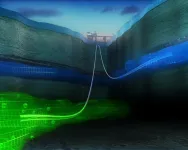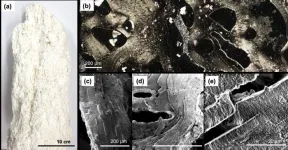Shrinking AR displays into eyeglasses to expand their use
2024-09-25
(Press-News.org) Augmented reality (AR) takes digital images and superimposes them onto real-world views. But AR is more than a new way to play video games; it could transform surgery and self-driving cars. To make the technology easier to integrate into common personal devices, researchers report in ACS Photonics how to combine two optical technologies into a single, high-resolution AR display. In an eyeglasses prototype, the researchers enhanced image quality with a computer algorithm that removed distortions.
AR systems, like those in bulky goggles and automobile head-up displays, require portable optical components. But shrinking the typical four-lens AR system to the size of eyeglasses or smaller typically lowers the quality of the computer-generated image and reduces the field of view. Youguang Ma and colleagues may have found a solution for condensing the technology. They combined two optical technologies — a metasurface and a refractive lens — with a microLED screen (containing arrays of tiny green LEDs for projecting images) to create a compact, single-lens hybrid AR design.
Their display’s metasurface is an ultrathin, lightweight silicon nitride film etched with a pattern. The pattern shapes and focuses light from the green microLEDs. Then, a black-and-green image forms on a refractive lens made from a synthetic polymer, which refines the image by sharpening and reducing aberrations in the light. The final image is projected out of the system and superimposed onto an object or screen. To further enhance the resolution of the projected image, Ma and the team used computer algorithms to identify minor imperfections in the optical system and correct them before light leaves the microLED.
The researchers integrated the hybrid AR display into a pair of eyeglasses and tested the prototype’s performance with computer image enhancement. Projected images from the one-lens hybrid system had less than 2% distortion across a 30° field of view — image quality that’s on par with current commercial AR platforms with four lenses. The researchers then confirmed that their computer preprocessing algorithm improved a reprojected AR picture of a red panda. The reprojected red panda was 74.3% structurally similar to the original image — a 4% improvement from the uncorrected projection of the image. With additional development, the researchers say the platform could extend from green to full color and enable a new generation of mainstream AR glasses.
The authors acknowledge funding from the National Natural Science Foundation of China, National Key Research and Development Program of China, and the Natural Science Foundation of Zhejiang Province China.
###
The American Chemical Society (ACS) is a nonprofit organization chartered by the U.S. Congress. ACS’ mission is to advance the broader chemistry enterprise and its practitioners for the benefit of Earth and all its people. The Society is a global leader in promoting excellence in science education and providing access to chemistry-related information and research through its multiple research solutions, peer-reviewed journals, scientific conferences, e-books and weekly news periodical Chemical & Engineering News. ACS journals are among the most cited, most trusted and most read within the scientific literature; however, ACS itself does not conduct chemical research. As a leader in scientific information solutions, its CAS division partners with global innovators to accelerate breakthroughs by curating, connecting and analyzing the world’s scientific knowledge. ACS’ main offices are in Washington, D.C., and Columbus, Ohio.
Registered journalists can subscribe to the ACS journalist news portal on EurekAlert! to access embargoed and public science press releases. For media inquiries, contact newsroom@acs.org.
Note: ACS does not conduct research but publishes and publicizes peer-reviewed scientific studies.
Follow us: X, formerly Twitter | Facebook | LinkedIn | Instagram
END
[Attachments] See images for this press release:

ELSE PRESS RELEASES FROM THIS DATE:
2024-09-25
Professor Ron Boschma is the first Dutch person to receive the Prix Vautrin Lud, the highest academic award within the field of geography. The award will be presented in Saint-Dié-des-Vosges, France on 6 October. Prior to the award ceremony, Prof. Boschma will give an invited lecture at the Sorbonne University in Paris on 4 October. Boschma was nominated for the award in recognition of his scientific contributions to the field of economic geography, especially for laying the foundations of evolutionary economic geography and his research into regional diversification and innovation policy. The European Union’s regional policy is based in part on his ...
2024-09-25
Research Highlights Risk to Both Humans and Wildlife, Suggests Need for New Collision Mitigation Strategies
A recent article published in PeerJ Life & Environment has uncovered insights into how mallards (Anas platyrhynchos) respond to approaching vehicles, revealing that these common waterbirds are poorly equipped to avoid collisions, particularly at high speeds. The research, which used both simulated and real-world vehicle approaches, highlights the urgent need for improved methods to reduce bird-vehicle collisions—events that are not only financially costly but also dangerous to both humans and wildlife.
The study focused ...
2024-09-25
About The Study: In this randomized clinical trial, home-based phototherapy was as effective as office-based phototherapy for plaque or guttate psoriasis in everyday clinical practice and had less burden to patients.
Corresponding Author: To contact the corresponding author, Joel M. Gelfand, MD, email joel.gelfand@pennmedicine.upenn.edu.
To access the embargoed study: Visit our For The Media website at this link https://media.jamanetwork.com/
(doi:10.1001/jamadermatol.2024.3897)
Editor’s Note: Please see the article for additional information, including other authors, ...
2024-09-25
Large expansion of carbon capture and storage is necessary to fulfill the Paris Climate Agreement. Yet a new study led by Chalmers University of Technology, in Sweden and University of Bergen, in Norway, shows that without major efforts, the technology will not expand fast enough to meet the 2°C target and even with major efforts it is unlikely to expand fast enough for the 1.5°C target.
The idea behind carbon capture and storage (CCS) technology is to capture carbon dioxide then store it deep underground. Some applications of CCS, such ...
2024-09-25
An “invisible forest” of phytoplankton is thriving in part of our warming ocean, new research shows.
Phytoplankton are tiny drifting organisms that do about half of the planet’s “primary production” (forming living cells by photosynthesis).
The new study, by the University of Exeter, examined phytoplankton at the ocean surface and the “subsurface” – a distinct layer of water beneath – to see how climate variability is affecting them.
Published in the journal Nature Climate Change, the findings show these two communities are reacting differently.
Over the last decade, the total “biomass” (living material) of subsurface ...
2024-09-25
Whether we are predisposed to particular diseases depends to a large extent on the countless variants in our genome. However, particularly in the case of genetic variants that only rarely occur in the population, the influence on the presentation of certain pathological traits has so far been difficult to determine. Researchers from the German Cancer Research Center (DKFZ), the European Molecular Biology Laboratory (EMBL) and the Technical University of Munich have introduced an algorithm based on deep learning that can predict the effects of rare genetic variants. The method allows persons with high risk of disease to be distinguished more precisely and facilitates the identification ...
2024-09-25
The hype surrounding machine learning, a form of artificial intelligence, can make it seem like it is only a matter of time before such techniques are used to solve all scientific problems. While impressive claims are often made, those claims do not always hold up under scrutiny. Machine learning may be useful for solving some problems but falls short for others.
In a new paper in Nature Machine Intelligence, researchers at the U.S. Department of Energy’s Princeton Plasma Physics Laboratory (PPPL) and Princeton University performed a systematic review of research comparing machine learning to traditional methods for solving ...
2024-09-25
There are more than 7,000 rare and undiagnosed diseases globally.
Although each condition occurs in a small number of individuals, collectively these diseases exert a staggering human and economic toll because they affect some 300 million people worldwide.
Yet, with a mere 5 to 7 percent of these conditions having an FDA-approved drug, they remain largely untreated or undertreated.
Developing new medicines represents a daunting challenge, but a new artificial intelligence tool can propel the discovery of new therapies from existing medicines, offering hope for patients with rare and neglected conditions and for the clinicians who treat them.
The AI model, called TxGNN, is the first one ...
2024-09-25
Francis Crick Institute press release
Under strict embargo: 10:00hrs BST Wednesday 25 September 2024
Peer reviewed
Experimental study
Animals
Combination treatment improves response to immunotherapy for lung cancer
Researchers at the Francis Crick Institute, in collaboration with Revolution Medicines, have tested a combination of treatments in mice with lung cancer and shown that these allow immunotherapies to target non-responsive tumours.
Their findings show that targeting tumours in ...
2024-09-25
Researchers led by Ryuhei Nakamura at the RIKEN Center for Sustainable Resource Science (CSRS) in Japan and The Earth-Life Science Institute (ELSI) of Tokyo Institute of Technology have discovered inorganic nanostructures surrounding deep-ocean hydrothermal vents that are strikingly similar to molecules that make life as we know it possible. These nanostructures are self-organized and act as selective ion channels, which create energy that can be harnessed in the form of electricity. Published Sep. 25 in Nature Communications, the findings impact not only our understanding of how life began, but can also ...
LAST 30 PRESS RELEASES:
[Press-News.org] Shrinking AR displays into eyeglasses to expand their use






